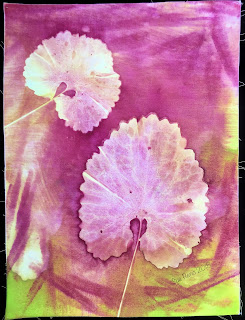For subject matter I used plants from a corner of the garden that needed to be weeded. The long oval leaves are burdock, the five pronged leaves are Virginia creeper, and the roundish ones are garlic mustard.
I combined the reds and purples with three different Dye-na-flow greens. I was in the moment and didn't keep track of what got used where. These are all on cotton sateen.
I covered the panels with glass and set them out in the hot sun. I let them expose for about 2 hours. As in my previous experiments, please be aware that I am purposefully ignoring the instructions on the correct way to use these products. Here are the exposed, un-washed prints.There was a nice amount of movement with the paint as the sun wicked it from under the leaves. And I think the Solarfast moved about a bit also, where it was under the leaves.
But the really exciting part is where the Solarfast dye struck almost instantly, leaving the marks of the foam brush I was using. This is a big difference from the usual heliographic paint prints I do with textile paints like Setacolor Transparent. I hope to exploit this tendency in the next trial.
The big question, though, is what would happen after exposure? The panels were still quite damp when I brought them in. The Dye-na-flow needs to be heat set, but the Solarfast needs a thorough wash out. What to do? I briefly considered trying to dry them, in lingerie bags, in the dryer, but that seemed both messy and likely to transfer color where I didn't want it. I also considered using lots of press cloths and trying to iron them dry, but that also seemed like a pain.
So I threw caution to the wind and just went ahead and washed them in hot water with textile detergent. Here are the results:
I was counting on the heat that built up under the glass during the exposure at least partially setting the Dye-na-flow, and that appears to be what happened. Some of it washed out, but much remained. I'm so pleased with the dynamics of these brush marks. These are nuanced and lovely prints, in my opinion, and I'm planning on trying this again.
There's lots of subtle brush marks in this one also, along with plenty of veining details. This will be fun to add stitching to.
As always, thanks for reading and commenting!
And a reminder that I also post on social media:
Facebook page:http://www.facebook.com/suerenostudio
Twitter feed: http://twitter.com/suereno
Tumblr: http://suerenostudio.tumblr.com
Instagram: https://www.instagram.com/sue_reno_studio/
And a reminder that I also post on social media:
Facebook page:http://www.facebook.com/suerenostudio
Twitter feed: http://twitter.com/suereno
Tumblr: http://suerenostudio.tumblr.com
Instagram: https://www.instagram.com/sue_reno_studio/












No comments:
Post a Comment